Resident Evil The Board Game Interview With Sherwin Matthews

Resident Evil is one of if not the biggest horror franchises in video games. I’m sure I’m one of the thousands whose first horror game was the original Resident Evil on PSX, So when I was on my honeymoon last year, I saw that Steamforged Games had a kickstarting going live for the Resident Evil board game. I immediately backed it. Cut to June 2022, when I got my email to update my shipping. I wanted to try and reach out to someone at Steamforged Games to talk to about the Resident Evil board game. Little did I know that I would hit the motherload when it comes to superfans, who also happens to be the lead designer at Steamforged Games Sherwin Matthews.
Justin: How did the idea to translate Resident Evil into a board game come about?
Sherwin: Do you mean the concepts of the game? Or do you mean how do we start approaching turning it into a video game into a board game?
Justin: You know, I’ll take both if you got both.
Sherwin: So my friend and my boss guy, Matt Hart, our creative director, used to work at Capcom. And he was the project lead at Capcom. And at some point, we released the Dark Souls board game. That was very, very successful and attracted a lot of attention. It is one of the first instances where people in the tabletop space started thinking about how we could make video games into board games. That brought a lot of attention to us, and some of that attention was from Capcom. So we sat down with them and said, well, let’s make a game together. And at that point, Capcom said, Well, we will be Remaking Resident Evil 2.
Sherwin: Now, in terms of the other question, how do you adapt Resident Evil to a tabletop space? The key thing we do when we approach any game is establish what we call the core DNA of the license. So we kind of sit there and say, what makes playing Resident Evil unique? And the answer to that question is it’s the fact that it’s not a flat-out constant assault on your senses. It’s not doom. It’s not loads of enemies at you and the frantic combat. It’s creeping dread. It’s suspense and terror slowly going up as you go through different rooms. It’s exploring the unknown. It’s that idea of resource management. I’ve only got X amount of bullets as an X amount of enemies and not enough healing items. It’s going from one place to the other to try and solve puzzles or answer some unfolding mystery before you. It’s layering in the different story elements and so on. So there’s a narrative in there, all of these different ideas that we kind of layer into that. And we identify those as the key sort of DNA of what the game is. And the next conversation is, how do we now adapt that to the tabletop because of some things we simply can’t do. So we achieved that through token cards, dice rolls, and various other mediums. And there are lots of tricks that we can employ. So, for example, one of the things we identified early on was resource management. So how about we have a dial that way, you attack with your handgun, and you count how many bullets you want to fire at the enemy. And then you actually count down the dial because that’s a psychological trick; you pick up this dial and interact with it. And don’t underestimate the psychological effect that has on people because they start off going at firing three bullets at anything; that’s fine. And then they get past 10, And suddenly it slows down. I’m going to fire two bullets this time. And then it goes down to five, and they’re like, I’m just going to try a one-shot because I’m lucky. It’s stuff like that.
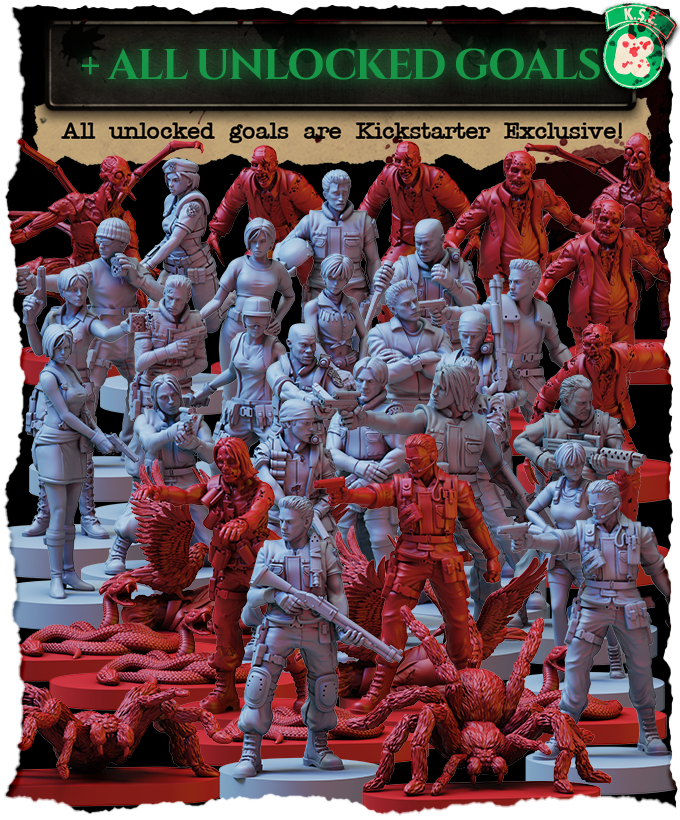
Justin: So did you find yourself going back and replaying the original Resident Evil a couple of times to nail down the feeling of the look and feel?
Sherwin: so when I first got the gig for Resident Evil to give you an idea of just how much I played these games. I had a conversation in the car on the way out to, basically every so often, our entire design development team gets together for what we call Design Week. And we all sit down together. And then basically, w talk about upcoming projects, we will share ideas and other bits and pieces like that. And it’s basically a big creativity help. And we’re on our way to one of those, and I had no idea why I was invited to this thing. So the time again, I was the lead writer. And then that’s when Matt sprung on me. By the way, I want you to make a Resident Evil game. And that’s where you’re coming today. And I’m like, oh my god, this is cool. So we arrived at this Design Week, and kind of Matt went off to go and have a chat with some of the other guys and left me to my own devices. So basically, I sat there and pulled out a notepad that I had with me. And when Matt comes back 20 minutes later, I’m like, okay, so here’s the map for all of the locations. This is how many things it is to translate into squares. This is the entire RPD building. This is the entire kind of sewers. This is the whole lab. I’ve also done Resident Evil 1 if we’re going to expand that as well. So here’s the mansion, all the other stuff. Here’s the original one, and here’s the map for the remake. So, before making Resident Evil 2 the board game, I clocked up somewhere in the region of about 500 hours or so. What was really nice during the campaign was I remember chatting to superfans and being like, hey, what’s the obscure camera angles in Resident Evil that you’ve never known about? And we just sat there educating each other about these weird ones. There’s one in the library under the stairs no one knows of. It’s like a little alcove you can run into where there are no items. There are no enemies. There’s no reason to have to go there. But it’s there.
Justin: Did you guys ever kind of play around with the idea of once somebody dies, maybe they have like a zombie character, or having one of those players play as the bosses and zombies and all that.
Sherwin: So the original version of the game that Matt pitched me his idea for actually had a DM, so a dungeon master who would be controlling the zombies, which, after a very quick chat, I kind of want to throw out. We’re very conscious of is that we have lots of people like yourself who are big Resident Evil fans who don’t really know anything about tabletop games. The whole game is designed to be accessible to that audience. But player elimination in games is really tough because what you don’t want to happen is someone gets an unlucky break or whatever dies, and then subsequently, they’re then out for the rest of that game session sitting there maybe for an hour or so to say I finished it I’m on my phone and bored. So you always want to have that point of tension where players are always engaged with it.
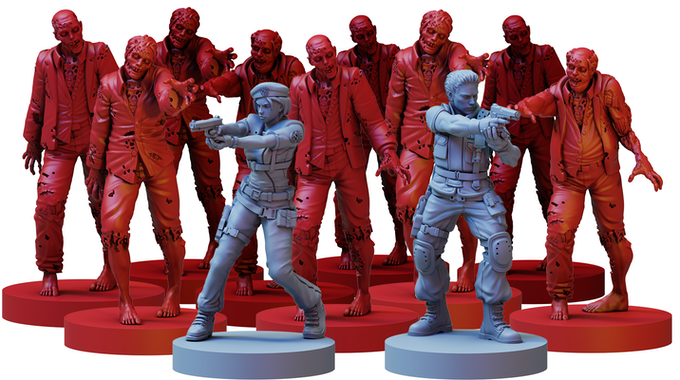
Justin: There are expansions for Resident Evil the board game. There’s Into the Darkness and Bleak Outpost. Do they add new objectives to the playthroughs? And could you play with both of those and the base game kind of like in a single play session?
Sherwin: So they’re both designed to be bolted into the main campaign, so they’re not standalone. You will need the core games to be able to play them. So Bleak Outpost explores some of the garden areas and then the guardhouse. And Into the Darkness, you go up to the third floor, hanging out with this cool cat called Yawn. And then also you get to explore a little bit of the garden area and then the caves. So what they do is they bolt into your regular campaign. So the honest answer is you couldn’t play in a single session purely because playing through, I mean, there are 19 scenarios in the core game, there’s another six, and each of those expansions, each scenario will take you some in the range of 90 minutes to play. So that’s, that’s a bit of time sitting at the table playing in this, but the game is designed so that you can pack it away after one or two scenarios or whatever. So, it’s more modular in that respect. You certainly couldn’t play it at once. So, for example, the last one of the caves has you running away from boulders and boulder traps that are kind of flinging boulders around at you, smashing down doors and walls and things, and you’re trying to rotate a tile. So the boulder goes down different paths and smashes open an entrance. So you can get out safely, Yeah, you’ve got some stuff in bleak outpost where you’ve got flooded tiles, and obviously, you’re trying to flip switches to flood the tiles, but then run through and dash through them before they kind of start to fill up again, because then you’ll drown in bits and pieces like that. We’ve also layered in into the tension deck for those expansions new tension cards, which add a sort of sub-objectives.
Justin: So, is there going to be easter eggs for fans of the series?
Sherwin: Absolutely yes. There are lots of small notes that we make. For example, in the Resident Evil 2, we added in the rookie, an item rookie picture of Rebecca, which, if you go through the card deck it is the 51st card.
Justin: That’s amazing! So speaking to the rest of the Resident Evil board games, is there anything that you brought forward design-wise to Resident Evil?
Sherwin:
Quite a bit, Yeah. There was the survival horror engine, as we call it, is relatively unchanged. Because obviously, much like the original games, if you’ve got something that isn’t broke, don’t fix it. So I wanted to find a way of putting in multiple enemy attack animations, especially because I knew I’d be working with hunters, and how to kind of make those different bits and pieces happen, which led to the development of a different system for special attacks. Then we polished up some stuff here and there. So yeah, there are always bits and pieces to learn. One of the things that we never do is rest on our laurels. There’s always the capacity to kind of learn and adapt and build forward. And sometimes those things are small polishes that kind of just make it shine a little bit more. And some of them are bigger and larger game engine changes like one of the things that for Resident Evil that was a big change is the exploration system. In the first two RE games, you lay out the entire map of the scenario populated with the different items and enemies and bits and pieces. And then you start playing it through. In Resident Evil One, because we want to reduce the setup time down, we put down a system whereby you only start off with a small part of the map you can play at any given time. And as you explore, you draw a card that shows you the next bit of the map you put down. And then you basically start exploring through. Now that was ostensibly something that was designed to break up set up. But what actually worked really, really well was this sense of suspense. You genuinely don’t know what’s around the corner because you simply can’t even see it at all.
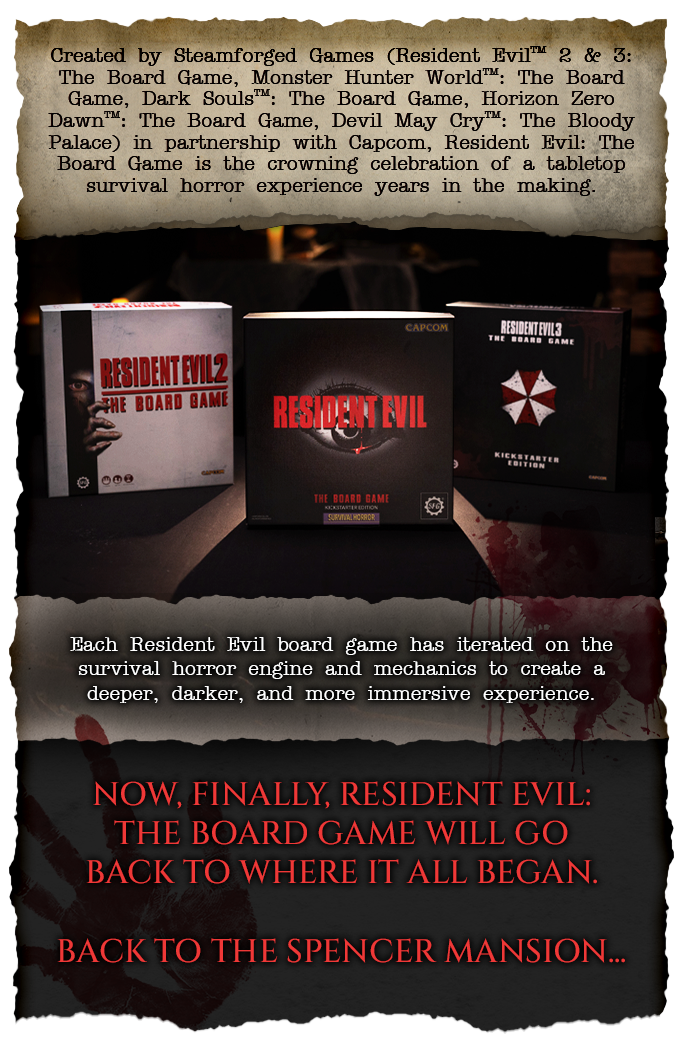
Justin:
Interesting. Okay, so how complex is the setup? I’m only asking because I mean, I have played games like Gloomhaven where it’s like, half an hour to twenty minutes to set something up.
Sherwin:
Yeah. I mean, the first time you set up, you have a little bit of setup because As you’re starting a campaign, there are very different decks, and there are bits and pieces. That said, once you’re done, for the most part, it should be pretty straightforward. You’ve got a deck of cards they don’t change once the campaigns begin. Ten to Fifteen minutes to set up a scenario, And that’s about it. So it should be pretty straightforward. It shouldn’t be too much. And the way that the way the rules are laid out is reasonably way perfectly designed as a game that I can teach you to play in the space of about three minutes.
Justin: So there were a lot of like exclusive Kickstarter items. Are the expansions exclusive as well, or are they also going to retail?
Sherwin: So most of them, if not all of their Kickstarter exclusive stuff, comes in the form of an alternate sculpt of a character. Alternatively, there’s a box, which is going to be called the Director’s Cut box. And that basically has all of the bits of pieces of stretch goals in terms of gameplay content, so new enemies, new characters, that sort of stuff in there. That won’t be going to retail. But the core game will, and so will the expansions. So most of the content goes but the other bit, there’s a few bits and pieces, which will probably sell for at well. I know that our normal thing is we’ll sell them via the SFG store while we have them left off for filling Kickstarters, so it’s not like they’ll disappear forever.
Justin: So speaking of the Kickstarter campaign, it was very social based this time, and kind of more based on community voting and the number of people instead of the amount of money. Where did that idea come from? I only asked because it was like it was an incredibly like unique and interesting way to do like a Kickstarter campaign.
Sherwin: It blew us away just how popular it was. Kickstarter is an endlessly fascinating beast. Perhaps it’s because I’m British, but it always feels really impersonal kind of saying, Hey, give us this much money. And we’ll give you this thing for free. That kind of feels a little bit rough. For whatever reason. I much prefer a system where we kind of have. I understand why you have stretch goals to generate excitement and so on. Instead, we wanted to turn it into something where we could really celebrate this because I said Resident Evil is a part of the 25th anniversary. Yeah. And we want to make it a celebration of what that was. We really want to replicate that sense of, hey, we’re in this together, let’s go through the mansion. So I kind of was sitting there noodling away and thinking, how can we make this interesting? How can we make this really shine? And then I had this crazy idea for let’s make it a narrative camera. Let’s make an open-world Kickstarter. No one’s ever done that before. Let’s make it so that everything is chosen by players. And it’s really cool. And it’s going to be super amazing. So then imagine trying to explain that through rough diagrams and PowerPoint presentations to Capcom. And also to the first of my colleagues who sat there going, Are you sure you can do this? I’m like, Yeah, don’t worry, I’ve got this, trust me. What sort of thing you’re planning on typing up like story content-wise, and we’ll go from there. So I did that. But the support for it blew me away. And you can absolutely be sure that it will come back. We had so much positive engagement. I mean, I remember there at the end of the comments where people were just saying, this was the best Kickstarter.
Justin:
Yeah, I know, for I mean, I was one of those people that when I backed stuff on Kickstarter, I was like, oh, yeah, here’s my money. Okay, I’ll come back when it’s done and find out when it’s gonna get shipped to me or whatever. But this was probably the first one I ever actually liked and stuck around for. Even though I was on my honeymoon, I would constantly check in on the character votes.
Sherwin: Yeah, I do apologize to your partner for that one. So hopefully, at least some of your characters that you want to survive survived.
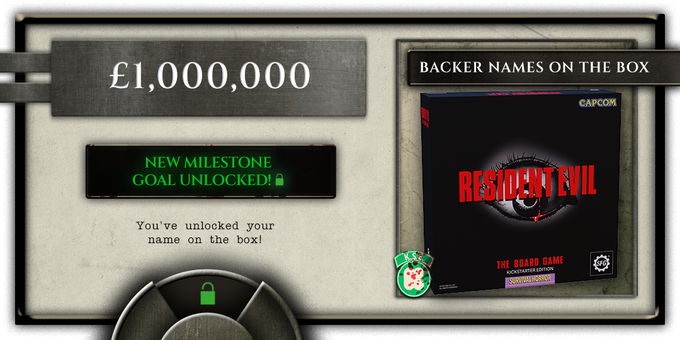
Justin:
So that kind of leads to a question. I’m not sure how if it’s okay to answer or not, was there anything not met or unlocked that you were personally hoping for to be?
Sherwin:
Oh, no, quite the opposite. Actually, we unlocked everything. We were always set up in a way whereby players were never going to miss out on anything. And what was interesting, and I didn’t anticipate, although perhaps naively, was that as soon as there was any hint of a character player, they’re running off to go save that character. So that’s why we got sort of somewhere through the campaign. Everyone’s alive right now. So I didn’t anticipate that.
Justin:
So and then kind of the last question I have for you. Well, the last two questions. If you had a dream license that you could work with that wasn’t Resident Evil that you would like to try to adapt into a board game, what would it be?
Sherwin: You know, I mean I have an obligatory requirement to say Dino crisis, right? Because obviously, everyone lost, I know, crisis. But the greatest game ever made is Vagrant Story. I love me some Vagrant Story. I play that once every year. Vagrant Story is I think if it came out now, I wouldn’t necessarily get it, or I’d have as much time for it. But it came out at the right time. When I was a student, I had a bit more time on my hands to really throw myself into it. And at that point, they really knew what the engine could or couldn’t do, what the actual console could and can do. So it really works. In terms of pushing the boundaries, and it’s just a really well-put-together game, it was very ahead of itself in terms of JRPGs. So, so yeah, I very much recommend trying out Vagrant Story.
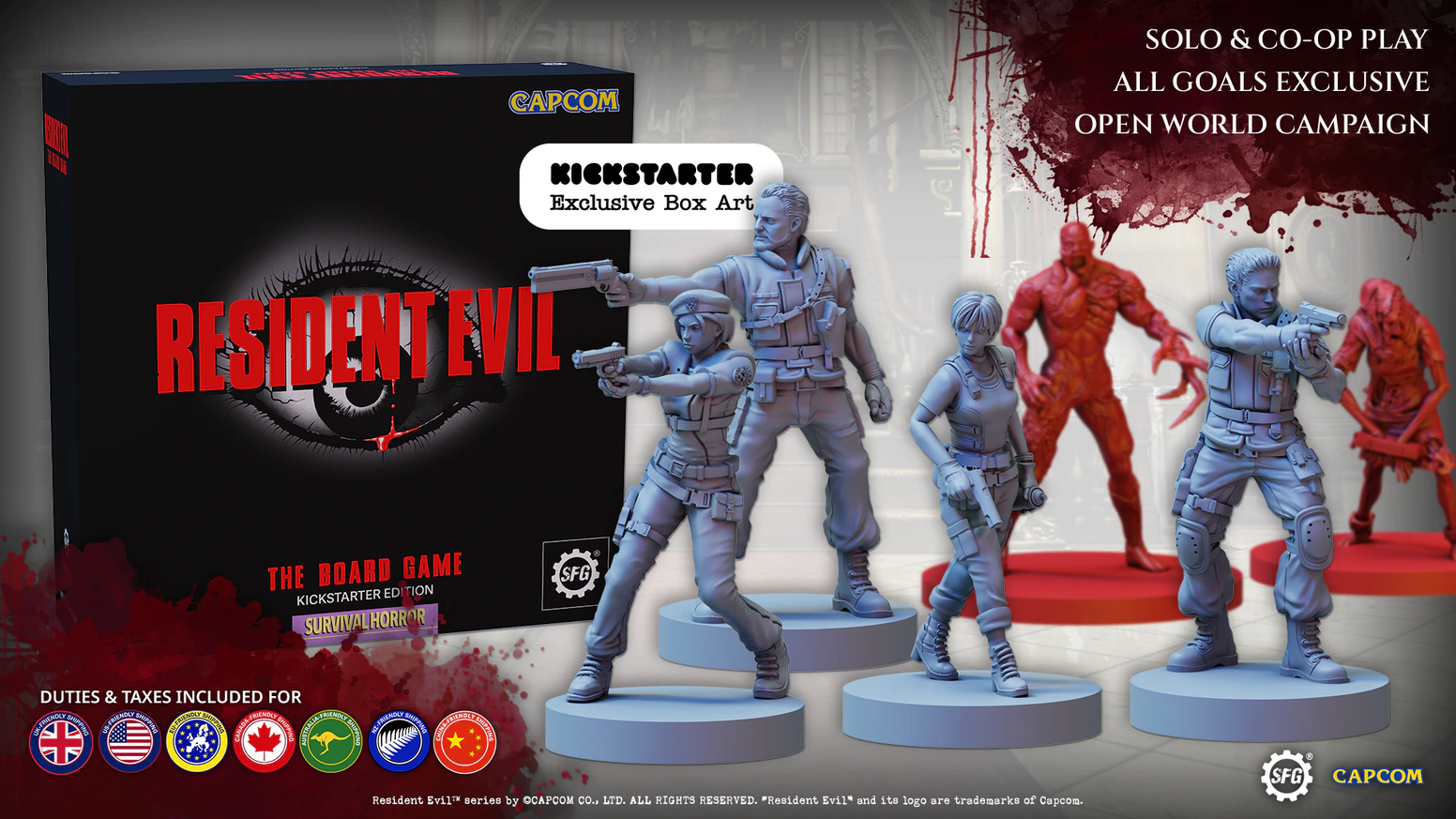
Justin: Interesting. Okay. Okay. And I don’t know if this date has changed or if it’s like set in stone, but there is a march 2023 date for Resident Evil. Is that still the case? I have heard that sometimes you can’t change the date on Kickstarters end.
Sherwin: So Kickstarter is always something where the delays happen. So certainly, you know, if we were to be delayed, we certainly wouldn’t be the first. Because one of the things that I said this isn’t our first rodeo. We’ve done quite a few now. And one of the things that we’ve got sophisticated and understanding is how timelines work and what we’re doing. We had a not terribly optimal experience with our first big Kickstarter, which was Dark Souls, which was mostly because it was just a massive scope for a project. And basically, we learned an awful lot from that experience. I mean, I say all this Touch wood that something completely out of nowhere will come. Resident Evil 2 was mildly delayed because we had a hurricane landed in China at the time and a whole bunch of Resident Evil 2 living at the bottom of the sea as a result of that Typhoon. But no, March 2023 Is still what we’re working towards at the moment.
Justin: I mean, that that’s, that’s all I have for you, really. I mean, it’s been exciting. It’s, it’s been nice to talk to you, especially because now I know that you’re a giant Resident Evil fan. It’s a nice feeling to know that the series is in good hands.
Sherwin: Thank you. Yeah, it’s been a real privilege to work on Resident Evil. I’ve met so many awesome people as a result of working on it and got to just hang out with super fans and really indulge my passion for the games in a way that I didn’t ever think I would do. It’s been cool. So I’m always humbled by it.
Thank you again, Sherwin, for sitting down and talking Resident Evil with me. After the interview, I did play a preview version of the game and let me say, they absolutely nail the survival horror feeling, and exploring the mansion is just as fulfilling as it is in the games. I can’t wait for March to see what Steamforged Games brings to life next.
Be sure to check out the Steamforged Games store and follow them on Twitter for updates on what they are cooking up!
For more interviews, features, and reviews, keep it locked into DreadXP, and check out Dread Delusion on Steam!
Categorized: Horror Gaming Interviews
